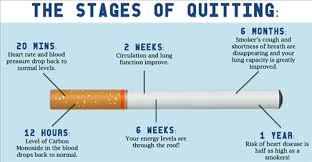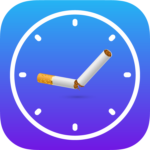A Canadian App developer is getting a boost from the original voice of Siri, Apple’s Virtual Voice Assistant to help people quit smoking.
In this article we explore the benefits of quitting smoking with the aid of technology. How to successfully quit smoking for good in 2020
A new app that helps people wean themselves from smoking cigarettes is now available (and soon from vaping) on the App Store. It’s called Quit My WayV.2 from Smart Addiction Technologies Inc. and it supports a smoker’s attempts to quit smoking at every stage of their attempts.
The Quit My Way app uses the evidence-based weaning method, thereby using and helping the brain and body become less addicted to nicotine. Eventually the body does not need nicotine anymore, and at that point, the new smoke-free person must change their behavior to begin life as a non-smoker. There is also a “social functioning” aspect of smoking cigarettes with friends and colleagues which plays a factor in people being able to quit successfully.
Technology is improving the accuracy and efficacy of smoking cessation and management of withdrawal symptoms. Technology empowers people to take control of their wellness. The Quit My Way app has different degrees of motivation as it provides controlled access to cigarettes over time.
It is well known that a person who tries to quit smoking will try several times before being successful. The quitting part is easy, the “staying quit” is the challenge.
Some approaches involve medication to curb the cravings; some involve addressing the tactile desires while others strive to alter the physiological symptoms. The key point is that patients will try multiple methods to achieve their goals.
The Quit My Way concept to quitting smoking works because it allows smokers to quit on their own terms, in their own time. 87% of smokers relapse at least once in the first three months of their quit attempt. This app is only $9.99, so if an individual relapses, the cost to restart the program is less than a pack of cigarettes.
“The concept of gradually weaning patients off of addictive substances is a tried, tested and true approach. I have had the opportunity to discuss this technology with multiple patients over the past month. Feedback was positive with many patients indicating that they would use this technology if it were readily available” says Dr. Andrew Smith MD, an Associate Professor at the Primary Healthcare Research Unit at Memorial University of Newfoundland Labrador.
A useful smoking cessation program has 3 main elements: Education, Motivation and Support.
The “What to Expect” page, in the app educates the user, also tells Hazel’s story of what she experienced when she was quitting, giving the user some peace of mind knowing what to expect, as most smokers start as teenagers, they have no idea what to expect after they have stopped smoking (coughing up black gunk for weeks/months is scary).
Most people are motivated by their loved ones. Once the app is set-up, it’s a good idea to choose pics from your phone/tablet gallery … the way the app works is, when it’s time for you to smoke the app pops up one of the pics you’ve chosen, just before you light-up, which truly helps to remind you why you are quitting in the first place.
Support is all around us, usually just a click away. Many of us rely on our social media platforms for support, what better, instantaneous support to introduce in the app. An optional function that allows the user to share their progress on their FB, Twitter or IG feed, to get Likes, Shares and High-fives from family and friends…
Studies show…
After the first day as a non-smoker, your pulse and blood pressure will start to drop back to normal. Your hands and feet will warm up to their usual temperature.
Your carbon monoxide level goes back to normal. Now your heart doesn’t have to pump so hard to try to get enough oxygen to your body.
At this time, you will have 50% less nicotine and 50% less carbon monoxide in your blood. Carbon monoxide is a chemical in cigarettes, and it crowds out oxygen in your blood. This causes problems in your muscles because they don’t get the oxygen they need. As the carbon monoxide levels drop, your oxygen goes back to normal.
Your sense of smell and taste returns 48 hours after quitting, getting sharper as your nerve endings start to heal.
Some people experience withdrawal symptoms such as headaches, nausea, cramps, sweating, irritability and depression. Nicotine creates a chemical dependency. The body develops a need for a certain level of nicotine, unless that level is maintained by smoking, or other means of nicotine, your body will begin to go through withdrawal. The withdrawal symptoms are only temporary, they peak 48 hours after you quit and will subside over the next 3 to 4 weeks.
After you stop smoking, cilia in your lungs start performing their duty again, your lungs begin ridding themselves of the harmful toxins. This may cause a cough lasting a few months until the cilia in your lungs are on their way to full recovery. Your body is also very busy with a lot of clean-up. Your lungs start getting rid of mucous, tar and other gunk left from cigarettes. This clean-up may take weeks or months to clear out all the built-up toxins in your lungs.
If you have asthma or COPD, your symptoms may get worse during the first week after quitting. That can be confusing, it’s part of the process and won’t last long. You’ll likely see improvement by day 3. You can also talk to your doctor about how to keep your symptoms in check.
By the end of day 3, you can breathe easier and have more energy. For most smokers, withdrawal symptoms will start to subside 2 to 3 weeks after quitting. At the same time, your body may be able to perform physical activity without feeling nearly as winded. You are now making great progress towards healthier lungs, which means a healthier you!
During the first 2 weeks to 3 months, you make huge strides. You can do more because your lungs are stronger and cleaner, and your blood flow has improved. Your risk of a heart attack decreases each day.
This may also be the time when the toughest withdrawal symptoms show up. You may feel anxious, dizzy, light-headed, hungry or tired. You might get headaches, feel bored or depressed. This is normal, but it also makes it a lot harder to keep from lighting up. Stay strong and know that this feeling won’t last. Things will only get better after you win this fight.
Stick to your plan. Go to a movie or any place where you can’t smoke. Lean on your support network, whether it’s friends or family who are rooting for you. Make a free call to a quit smoking hotline in your area, the toll-free numbers can be found in the Quit My Way App and in other smoking cessation apps as well.
Within the 3 month period, you’ve made it through the hardest part of the withdrawal phase. You may still get light cravings; everybody has different triggers for wanting to smoke. You can’t eliminate them all, but you can stick to your goal, it gets easier as time goes by. Ask for help if you need it. Think about all the money you’re saving and take a few deep breaths, nice and slow.
During the 3 to 9 months after quitting, you can take deeper, clearer breaths. Instead of hacking, you cough in a helpful way that continues to clear the harmful toxins out of your lungs. This helps you get fewer colds, lung infections and other illnesses.
At the end of year one, you’ve reached an amazing milestone! Be proud of yourself! Now your risk of heart disease is half of what it was a year ago. Your chances of a stroke and cervical cancer are now the same as a non-smoker.
After 10 years, and compared to someone who still smokes, you’re now half as likely to be diagnosed with lung cancer. And you are less likely to get cancer of the larynx and pancreas.
Finally, after 15 years of not smoking, your body has done a great job of recovering and healing. The chance that you’ll get heart disease is the same as if you’ve never smoked at all.
There are so many benefits to quitting, including improved health, higher energy levels, a lessening of negative thoughts – including the innate fear of dying from smoking; the amount of money saved; we smell better, and we recoup all our time back. Because a smoker is addicted to nicotine, they spend most of their day wondering when they will get their next fix of nicotine.
The effects of Vaping and E-Cigarettes
The Quit My Way App focuses on helping engage and empower people to quit smoking cigarettes using evidence-based strategies, but with 8% of Americans now using e-cigarettes or vaping for their hit of nicotine, there is an urgent need for advanced technical solutions to help them quit as well.
“Smoking cessation solutions historically consisted of telephone coaching or in-person classes. They haven’t adapted to the needs of American consumers. All of that changes with ‘Quit My Way’. People can get the help they need when they need it, immediately at their fingertips’, says Hazel Harrison, Founder of Smart Addiction Technologies.
Quit My Way uses a combination of innovative technology, human-centered design, behavioral science, and interactive support. The App presents participants with personalized content to help them understand their patterns tied to smoking. These insights are then used to develop a quit plan orchestrated specifically to their unique situation and motivations.
Quit My Way’s continued innovation moves us all closer to a nicotine-free world. By extending its solution to address vaping and other forms of nicotine use, Quit My Way broadens its reach and ability to empower even more people. When individuals are given the tools to gain control of their health, that, at scale, can change the world.
Today, Quit My Way is available on The App Store. In the future, the team plans to offer it through self-insured employers and health plans.
In speaking with Hazel Harrison, I learned she spent months working on the algorithms for the program. A lot of insight and clarity was gained from the first user study. Study participants (real smokers trying to quit) helped so much with their input to improve the Quit My Way app.
Quit My Way combines a physician’s guiding principle of ‘Do No Harm’ with Trigger Diffusion, Motivation, Education and Support creating the smartest smoking cessation technology this generation has ever seen. Please check it out and Quit Safely at: http://www.quitmyway.com/about
TESTIMONIALS
“Love this app! This app is really user friendly. Great place to start if you would like to quit smoking” Meggan
“Nearly four years ago I lost my dad to lung cancer from smoking. I wish this app was around then it may have worked to help him quit smoking. This app helped me wean myself off cigarettes.” Student“Straight forward, easy to use no unnecessary features.” Scarlett Red
#quitsmoking #QSWB ##CCHealthTip #smokefree #tobaccofree


